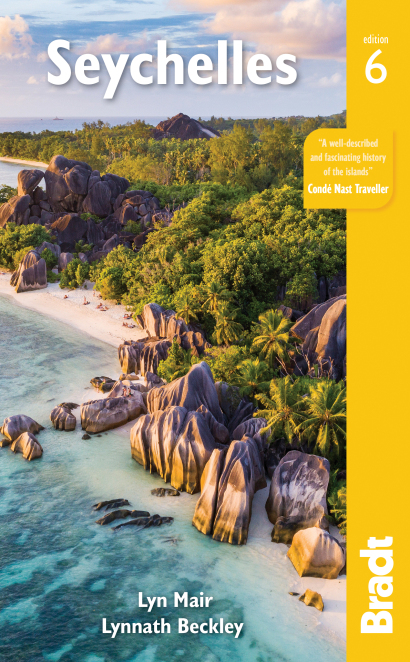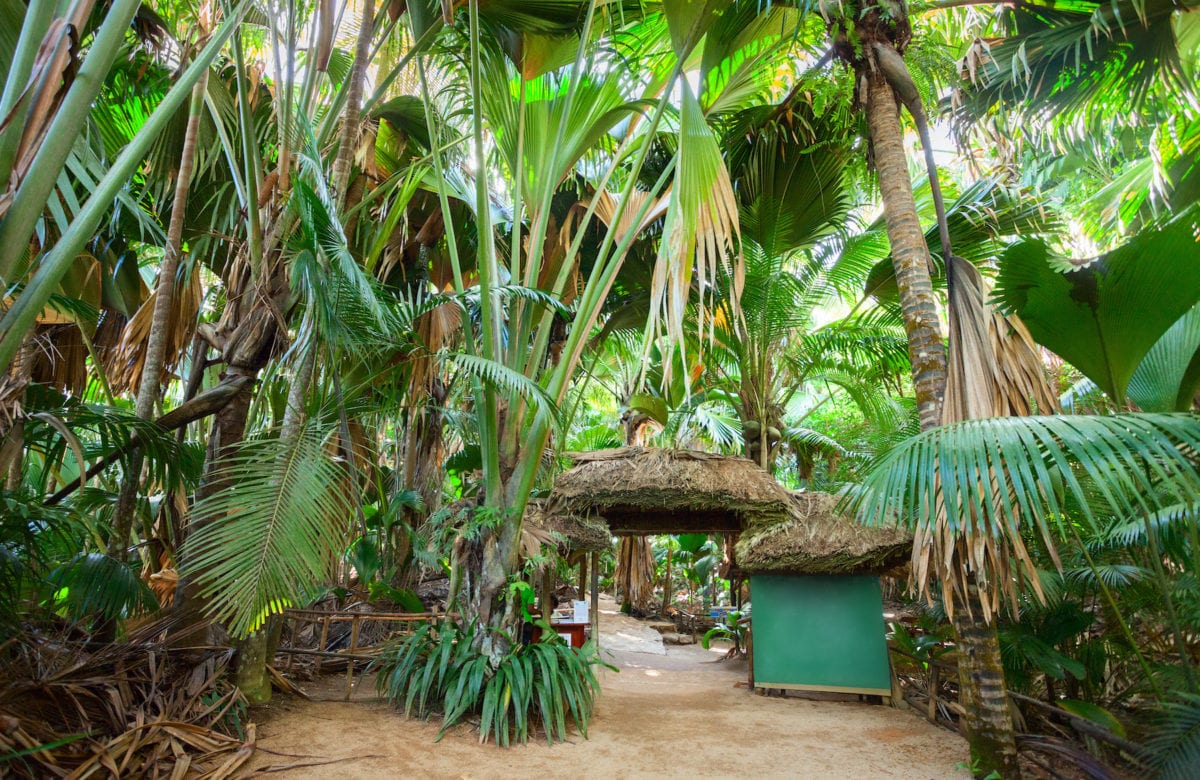In the deep blue of the western Indian Ocean, 115 unique and exquisite islands lie randomly scattered like emeralds and sapphires from a jeweller’s purse.
Lyn Mair and Lynnath Beckley, author of Seychelles: The Bradt Guide
The Seychelles are famous for their palm-fringed silvery sands, secluded coves bounded by granite boulders, misty mountain peaks cloaked in forest and coral reefs extending into the warm ocean. Coupled with idyllic days in the tropical sun, velvet nights under starry southern skies, delightful people and charming Creole culture, they beckon discerning travellers to their shores.
The main, populated islands of the Seychelles lie a few degrees south of the Equator and rise from shallow banks as huge granite rocks, reflecting their ancient continental origin. Other remote, coralline islands, inhabited by millions of seabirds, arc out towards the shores of Africa and Madagascar. One of these is Aldabra – a wilderness atoll where time flows with the tides and nature rules supreme.
The Seychelles has a short, but fascinating, history of explorers, pirates and settlers. The Creole people, a harmonious mélange of African, European and Asian descent, have a happy-go-lucky lifestyle and, although global travel has come to them, they maintain their traditions of language, music, dance and food.
The Seychelles has an ambience of remoteness. It is a modern country with accommodation ranging from exclusive lodges to family-run guesthouses. Island hopping can be accomplished with ease using fast ferries, aeroplanes and helicopters, and what better way to explore than in your very own (or chartered) yacht?
However, there is more to the Seychelles than basking in the sun. The Seychelles has many secrets, discovered as you explore the islands – coco de mer palm forests, the busy little capital of Victoria, picturesque La Digue, island bird sanctuaries, weather-beaten glacis, the local market, Creole cuisine…
After a day’s exploring, savour the evening. Sip a Seybrew on a beach coloured by a fiery sunset, wait for the southern constellations to grace the enveloping night, and plan another perfect day in paradise.
For more information, check out our guide to the Seychelles
Food and drink in the Seychelles
Imagine the freshest seafood, flavoured with coconut milk, garlic, ginger, limes and chillies, and cooked to perfection by chefs who know how to make a thousand different fish dishes! Creole cuisine in the Seychelles combines the subtlety of Asian food with the spices of Indian cooking, all moulded by fine French flair.
Rice is the staple and fish is eaten almost every day. Soup is a tasty starter and is often made from tec-tec, a tiny shellfish. Bouillon blanc, a fish soup that uses a whole, small fish with loads of garlic, ginger and chilli, is a meal in itself. Salads are made with sweet, little purple onions, tomatoes and crisp bilimbis which resemble tiny cucumbers. Millionaire’s salad used to be prepared from the heart of the rare palmiste palm, but now the heart of the coconut palm suffices.
Curries are traditional – usually fish or octopus – and quite delicious. Breadfruit, plantain, cassava and sweet potatoes provide alternatives to rice. Chatinis or chutneys are side dishes made by grating green papaya or the local fruit known as the golden apple, which is fried with a little onion and served in fresh lime juice or vinegar with ginger and garlic. Dried fish such as shark or tuna can also be prepared this way. Little chillies are often served on the side – they can be dynamite, so try with caution!
Breadfruit, with the addition of island spices and coconut milk, is also used for sweet desserts. Other desserts are prepared from coconut and bananas and are usually very sweet and sticky.
Many restaurants serve excellent Creole food so tourists can get a taste of the islands. However, most hotels and restaurants also serve international cuisine with a wide variety of choices. Some of the largest hotels have speciality restaurants (Indian, Italian, French, Japanese and Chinese) which serve really good and tasty meals.
Vegetarian/vegan food can be a little difficult as a lot of fresh vegetables and salads have to be imported. Pizzas are available and there are many local take-away options, particularly during the daytime. In general, eating out is expensive so the half-board options at hotels are usually a good deal.
The national drink is the locally brewed beer, Seybrew, which, when chilled, slips down ever so easily! It is available in 280ml returnable bottles or as draught in various bars and restaurants. The brewery also makes Eku lager and Slow Turtle cider; Guinness is also made under licence. The Seychellois drink an amazing amount of fizzy soft drinks, and fruit juices are also readily available.
Health and safety in the Seychelles
Health
The islands of the Seychelles pose no great health threats, and probably the worst thing that could happen is sunburn or dehydration. The standard of living is generally high and there are no awful unsanitary conditions.
Consult the official Seychelles government travel advisories for the latest requirements with respect to the Covid-19 pandemic. A requirement for the Seychelles is proof of vaccination against yellow fever for travellers aged one and over who are arriving from an endemic area (eg: sub-Saharan Africa) or who have transited in an endemic area for more than 12 hours.
In addition, travellers are wise to be up to date with routine immunisations such as tetanus, diphtheria and polio (now given as the all-in-one vaccine Revaxis, which lasts for ten years) and should check that they are immune to measles, mumps and rubella either through vaccination (MMR – two doses given at least one month apart) or through disease.
Special circumstances may dictate that other vaccines are advised. Hepatitis A and typhoid vaccine should be considered if you are living with locals, staying for more than a month or at more at risk of disease through lifestyle or occupation. If you are intending to work in a hospital/medical setting or closely with children then hepatitis B vaccine is recommended.
The risk of rabies exists only in the bat population so is considered as low risk. If you wake with a bat in your room and you are not under a bed net or think you have been bitten by a bat then seek medical advice as soon as possible.
Sensible preparation will go a long way to ensuring your trip goes smoothly. Particularly for first-time visitors to Africa, this includes a visit to a travel clinic to discuss matters such as vaccinations and insect bite prevention. A full list of current travel clinic websites worldwide is available here. For other journey preparation information, consult Travel Health Pro or CDC: Traveller’s Health.
Safety
The Seychelles is not a crime-ridden part of the world. However, most of the larger hotels have safety deposit boxes for your valuables like tickets, cash and passports. When out and about, use your common sense. For example, it is not wise to leave fancy, expensive camera equipment lying on the back seat of an unattended open vehicle. Neither is it a good idea to leave a handbag on the beach while you go swimming or snorkelling.
Female travellers
It is generally safe for women to be out on their own and travelling on the buses is absolutely fine. Take care not to offend the local people by wearing ultra-skimpy clothes that could be misinterpreted as provocative.
LGBTQ+ travellers
There is no problem with gay and lesbian travellers, but it is always wise to be discreet. Homosexuality was decriminalised in the Seychelles in 2016.
Travellers with a disability
Wheelchairs are available at the airport and at most of the larger hotels. It is advisable to confirm with your hotel and notify the tour agent of any disabilities prior to travelling to ensure that the accommodation is suitable. Depending on the degree of disability, travelling in small boats could be difficult.
Travelling with children
The Seychelles is generally a wonderfully relaxed country for children but do be aware that a few hotels do not accept children under certain ages.
Travel and visas in the Seychelles
Visas
On arrival, it is necessary to have a return ticket and a current passport that is valid for six months after the scheduled date of departure from the Seychelles. Proof of accommodation is also necessary and, if you have not made a booking, an official at the airport will take you aside and organise your accommodation there and then, even if it is late at night.
A one-month entry permit will be issued on arrival, and this may be extended for a further two months provided you have proof of funds to cover your stay. Extensions may be obtained from the Department of Immigration.
Consult the official Seychelles government travel advisories for the latest requirements with respect to the Covid-19 pandemic. If you have been in a yellow fever country within the past six days a yellow fever vaccination certificate is needed.
Getting there and away
As the Seychelles islands are in the middle of the ocean, almost 1,000 miles from anywhere, there are only two ways to get there – by air or by sea.
By air
Regular flights link the Seychelles with Europe, Africa and the Middle East. Air Seychelles, with its bright red, green, blue and white livery and the white fairy tern logo, is the national carrier. It originally only provided a service from Mahé to Praslin and Frégate with foreign airlines bringing in the tourists. However, in 1983, Air Seychelles launched its first international flight from Gatwick, London, using a DC10 aircraft.
Recently, Air Seychelles has been restructured, is code sharing with Etihad Airways, South African Airways, Air India and several other airlines and is presently flying between Mahé, Johannesburg, Mauritius, Antananarivo, Dar es Salaam and Mumbai.
Several other airlines fly to the Seychelles: these are Air France; British Airways; Emirates Airlines; Ethiopian Airlines; Etihad Airways; Kenya Airways; Qatar Airways; Sri Lankan Airlines; and Turkish Airlines. Flight schedules vary so check websites for details.
The busy Seychelles International Airport is located on Mahé, right on the edge of the ocean, just 9km south of Victoria. Constructed in 1971, on land reclaimed from the sea, the international airport terminal buildings have undergone major renovations and there is now a separate domestic terminal.
By sea
Cruise and expedition ships dock at the port of Victoria in Mahé, mainly from November to April when the seas are calmer. The larger cruise ships generally only visit Mahé but occasionally do anchor off Praslin and transport passengers ashore with their own boats. Smaller expedition ships often include the outer islands in their itineraries.
By yacht
Visiting by yacht must be the finest way to explore the fabulous islands of the Seychelles. All visiting yachts must obtain clearance with Customs, Immigration and Health in Victoria, Mahé. Hefty tariffs previously levied on cruising yachts visiting the Seychelles appear to have been rescinded. For further information, contact the Seychelles Port Authority.
When to visit the Seychelles
The equatorial climate is hot all year round, and is governed by the two wind regimes. The southeast trade winds blow steadily from May to October and, during these months, very little rain falls and the days are hot, humid and sunny. Most of the rain falls during the northwest monsoon period from November to March. The highest rainfall occurs in December and January but don’t let that put you off as, even when it pours, it is not cold. The tropical downpours tend to occur in the afternoons and are short and sharp. Getting drenched in a tropical downpour could be a whole new experience!
For further information, contact the Seychelles meteorological office.
Climate
The humid, tropical climate of the Seychelles and the western Indian Ocean is controlled by a host of interrelated factors. These include the monsoonal wind shifts induced by seasonal barometric pressure changes over the Indian Ocean, Africa and India; changes in the position and intensity of the south Indian Ocean high- pressure zone; seasonal migration of the complex inter-tropical lows; and ocean currents and sea surface temperature patterns in the equatorial Indian Ocean.
Wind direction and speed in the Seychelles display clear seasonal patterns. In the southern hemisphere winter (May to October), southeast trade winds (vent swet) extend over the western Indian Ocean south of the Equator and, in the Seychelles, there is dry weather with low rainfall. In the southern hemisphere summer (December to March), on the other hand, the south Indian Ocean high-pressure system shifts southwards, and the rainy northwest monsoon (vent nord) sets in over the islands.
In the transitional months of April and November winds tend to be light and variable. In general, mean wind speed is higher in Aldabra than Mahé. Tropical cyclones do not occur in the granitic Seychelles as they lie too close to the Equator but they do occur infrequently on Aldabra, Assumption and Farquhar.
Annual rainfall exceeds 800mm on all the islands and temperatures are always above 20°C. There are, however, important climatic variations between the islands which arise primarily because of the wide expanse of ocean covered by the islands, and altitudinal differences between the high granitic islands and the low coral atolls.
Mean annual temperatures in Mahé (Victoria) are 26.6°C and 27°C on Aldabra, with only a 3°C seasonal variation. In the mountainous granitic islands, temperature decreases with increasing altitude. Humidity is usually around 75– 80% and varies little with the season. Humidity does vary with altitude and the mountains are often shrouded with mist for long periods.
Itineraries
If you want to view and compare sample itineraries, please see the Seychelles beach holidays section on SafariBookings. This comparison website lists tours offered by both local and international tour operators.
What to see and do in the Seychelles
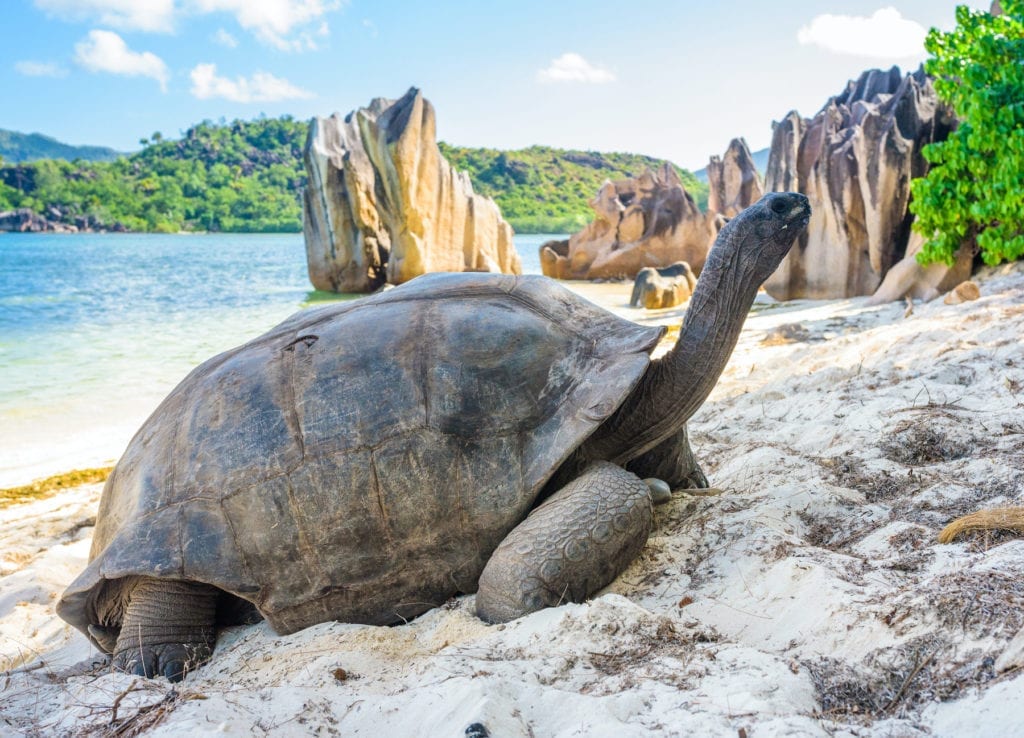
Aldabra
Rugged, rough and remote, this World Heritage Site wilderness atoll has survived the ravages of man over the centuries because of these very characteristics. The harsh and arid nature of the atoll, with its sharp, jagged, limestone terrain and thick, impenetrable vegetation, prevented the full-scale exploitation that beset most of the other Seychelles islands.
Although it is not, and never has been, on any regular shipping routes, it was first recorded on early Portuguese charts in 1509, and it is highly likely that discovery by Arab seafarers preceded this date. The evocative name Aldabra probably stems from the Arabic word Al-Khadra meaning green, which could be a reference to the green-based cloud that can sometimes be seen hanging over the atoll, reflecting the colour of the vast interior lagoon.
The elliptically shaped atoll is approximately 34km long and about 14km across, which makes it the largest raised coral atoll in the world. The rim of the atoll is broken by four channels which link the massive, shallow lagoon to the ocean. The four islands thus formed are Grande Terre or Main Island, which is by far the largest; Picard, hosting the settlement; Polymnie, the smallest; and Malabar, which runs straight along the northern edge of the atoll.
Fringing platform reef encircles almost the entire atoll. The jagged, fossilised limestone cliffs undercut by constant wave action, and the desolate sand dunes rising up to 15m above sea level, form the barrier between sea and land. Many of the islets inside the lagoon are champignon with a flat, tabular surface and a slender limestone stalk. Some are barren while others are covered in a variety of flowering plants including orchids and mangroves.
What to see and do on Aldabra
The warden and expedition leader will plan any excursions, taking into account the weather and state of the tide. All visitors have to be accompanied by Aldabra personnel at all times; no-one is allowed to wander around on their own and a strict set of guidelines needs to be adhered to regarding the flora and fauna.
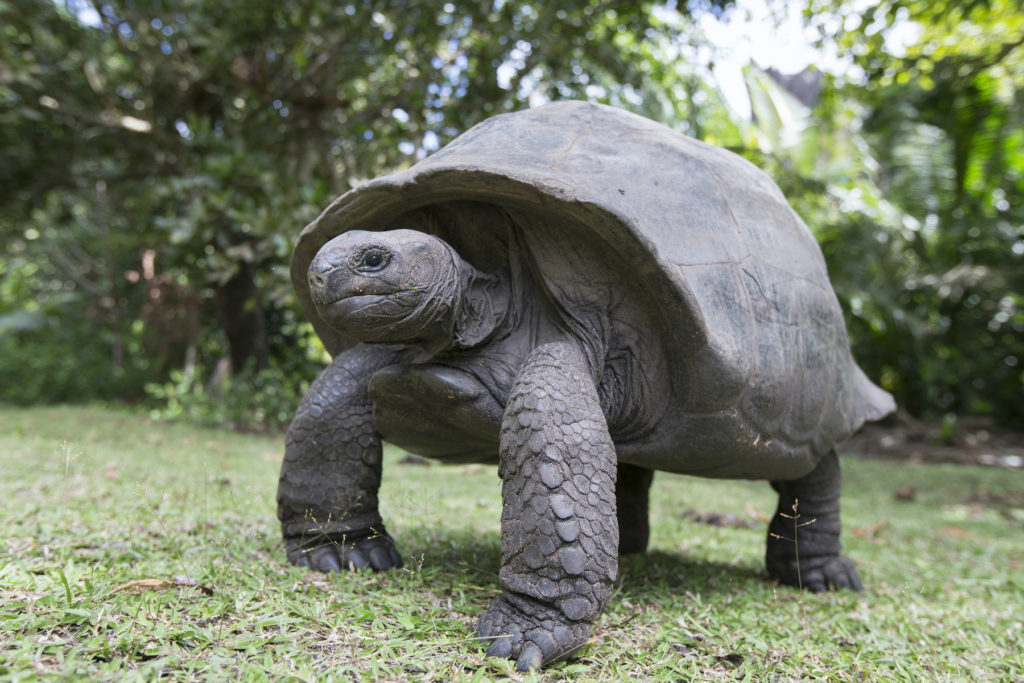
Giant tortoises
There are only two places in the world where giant tortoises still occur naturally: the Galápagos Islands in the Pacific, and Aldabra. The Aldabra population of about 100,000 is much greater than that of Galápagos.
These great, lumbering herbivores are easily seen around the Picard settlement grazing on the short turf. The tortoises are generally shy and on being approached will hiss and retreat into their shells, except, that is, for one very large and friendly tortoise near the settlement that loves having his neck stroked!
Walk to La Gigi
From the settlement on Picard you can walk to La Gigi, a small promontory at Passe Femme on the West Channel where you can see the World Heritage Site plaque resting on a coral cairn. At low tide it is possible to venture a little way up the edge of the lagoon and see four species of mangroves and typical champignon, some upright and others collapsed into the shallow water.
The breathtaking views across the near-empty channel touch the soul, and the timeless beauty of the vast lagoon merging with the sky will be a lasting memory. Birds feed on the exposed coral reef, and frigates, boobies and white fairy terns wheel overhead as they have done for centuries. The only sounds are the distant thunder of the surf crashing on the reef and the friendly twangs of the white fairy terns as they curiously inspect the visitors.
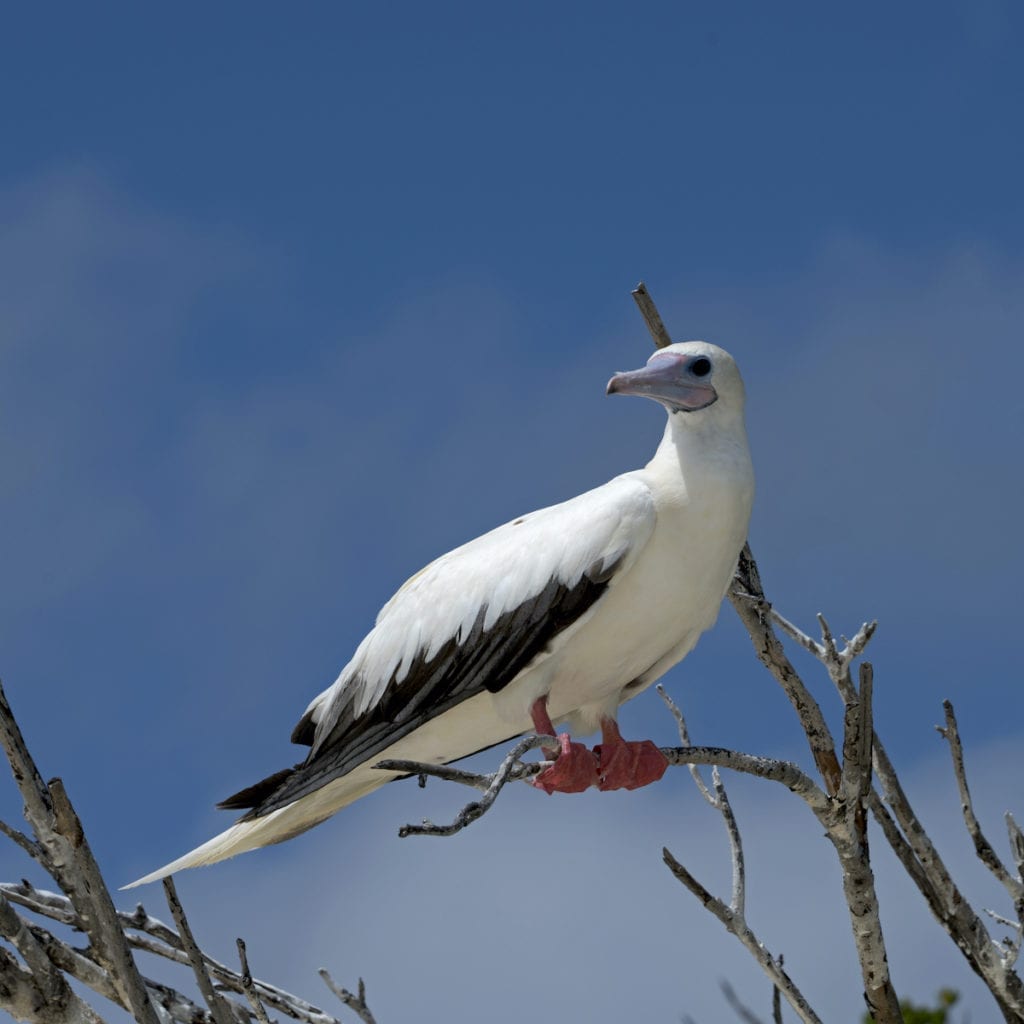
Birdwatching
Depending on time and tide, it may be possible to visit one of the frigatebird coloniesinside the lagoon by boat. However, be aware that if the boats approach too close, the noise of the boat engines causes the most incredible disturbance to the courting or nesting birds.
While inside the turquoise-green lagoon it might also be possible to stop on Polymnie, Picard or Malabar to look for the white-throated rails. They are curious little birds and will often come to investigate the arrival of strangers.
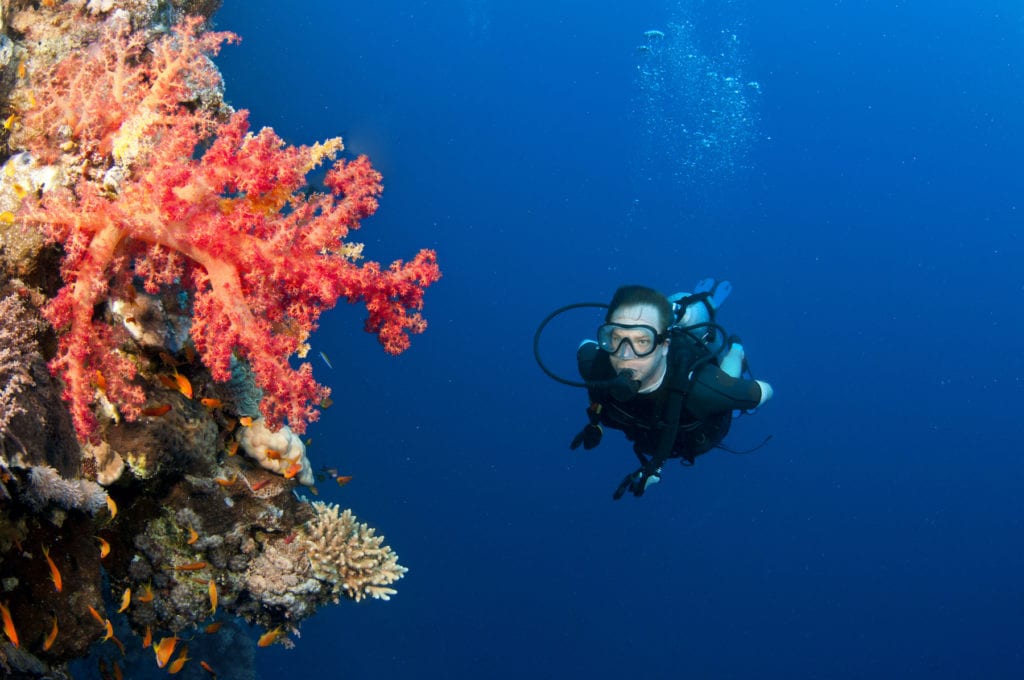
Diving
Diving and snorkellingat Aldabra are fabulous, particularly near the entrances to the channels. However, tidal currents are strong, so take advice from the warden and his staff.
There are lots of turtles, big groupers, blacktip reef sharks and stingrays, and the vertical reef drop-off is marvellous. The corals are in good condition and the fish life is prolific.
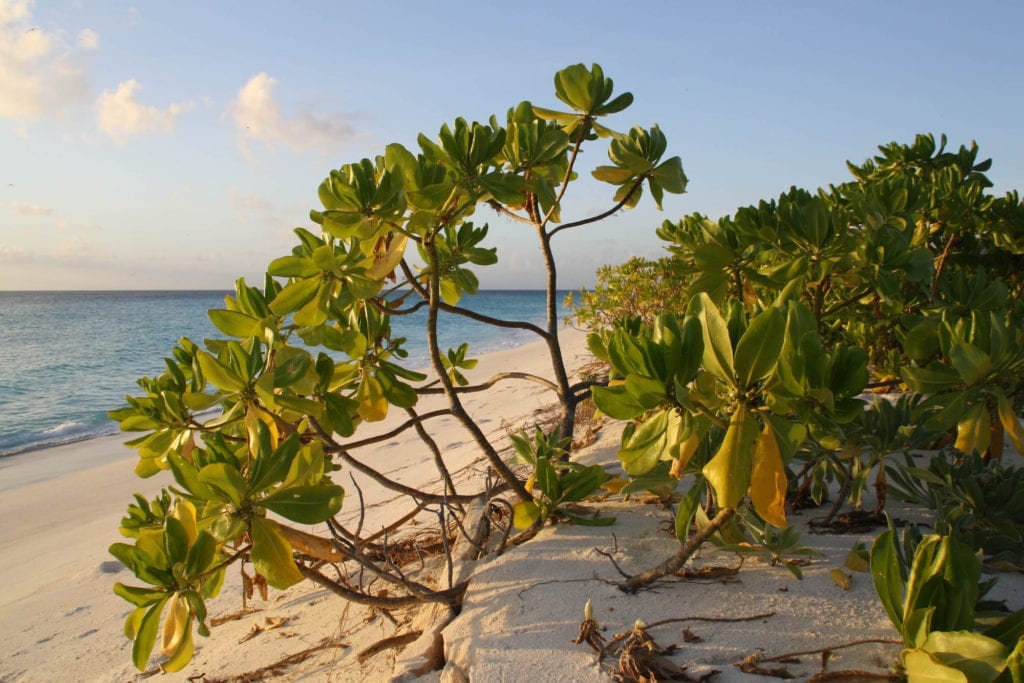
Bird Island
Remote Bird Island, another privately owned sandy speck in the ocean, lies 105km northwest of Mahé on the edge of the Seychelles Bank. It is, in fact, the most northerly island in the Seychelles, being a mere fraction closer to the Equator than Denis. It covers only 70ha of land, is 1,500m long and 750m wide.
Very little is known of the early history of Bird but the first recorded visit was in 1771 when the master of The Eagle charted the island. In 1808, a French privateer, Hirondelle, with 180 people on board, was wrecked on the reef and the survivors remained on the island for three weeks while they constructed a raft, before sailing to Mahé.
Bird was originally called Île aux Vaches (‘Island of Sea Cows’), after all the dugongs that grazed on the prolific seagrasses in the clear waters. They have become extinct but the island is still sometimes referred to as Île aux Vaches and it appears on many maps as such.
In 1896, guano was already being mined on the island and 17,000 tonnes were removed between 1900 and 1905. At the end of that phase, coconuts were planted for the copra industry. The present owner bought the island in 1967, an airstrip was cleared, and a small tourist lodge was developed. He declared the island a wildlife sanctuary in 1986 and the lodge was upgraded. Over the years, the lodge has been enlarged and upgraded but it remains a delightful, unpretentious hotel with a blend of hospitality, relaxation and simplicity in a natural environment.
What to see and do on Bird Island
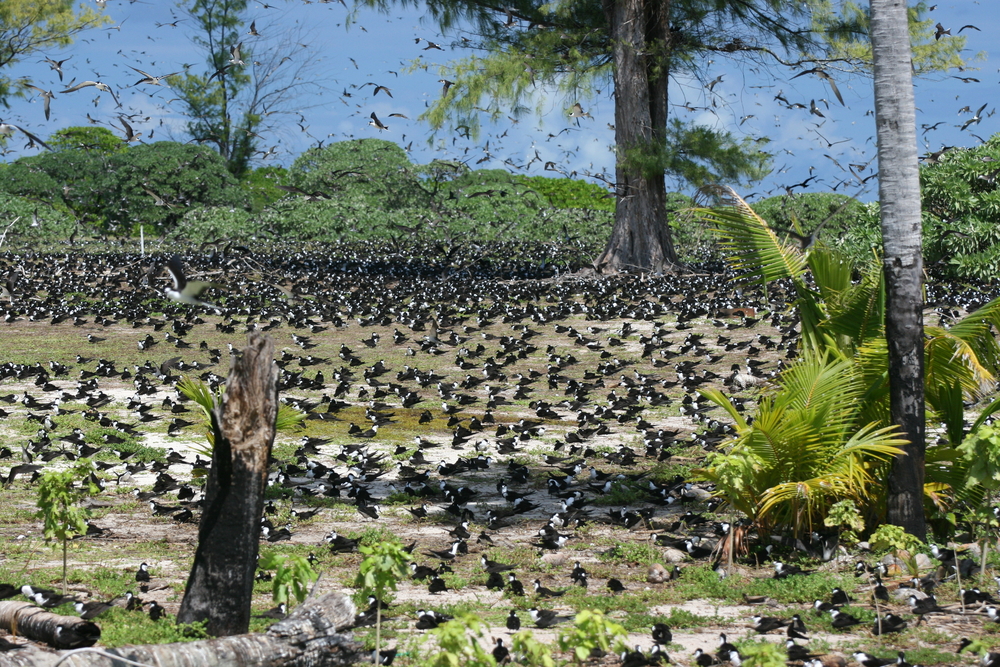
Birdwatching
Bird, as its name implies, is for the birds, and they are the main tourist attraction of the island. Walking paths traverse the island and reveal a variety of natural and introduced plants. Guests are free to wander anywhere around the nature reserve on easy and well-marked sandy paths. Besides, it is such a small island you could never get lost!
About 800,000 pairs of sooty terns breed there during the southeasterly trade wind season. Their first ‘wide awake’ calls are heard as early as mid-March when they start gathering prior to nesting. Great noisy masses of terns swirl over the island like a low, hazy cloud and by June they are laying their eggs.
The sooty tern colony is at the northern end of the island, reached by walking along the beach and following the sign inland. A small raised platform enables guests to have a good view over the nesting ground without disturbing the birds.
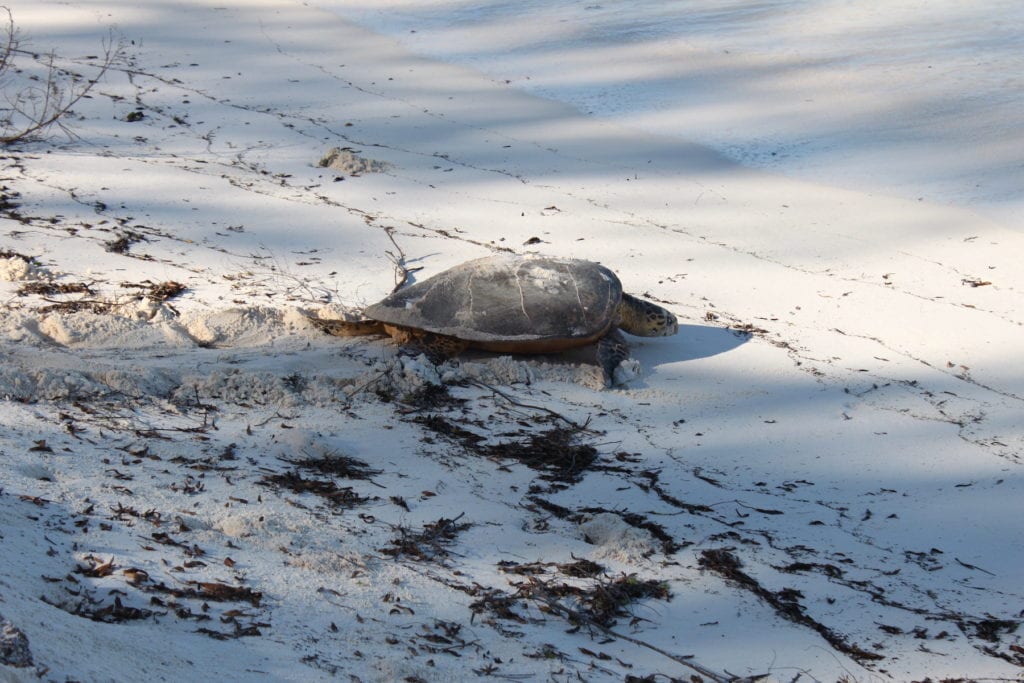
Tortoises and turtles
Besides the birds, 24 giant Aldabra tortoises live out a quiet life, roaming wherever they please, even grazing the airstrip. The largest tortoise in the world, Esmeralda, lives on the island and when he was weighed by the Royal Zoological Society in 1980, he broke the scales at 303kg and is reputed to be around 250 years old! Two yellow-and-black radiated tortoises from Madagascar, called Jeremy and Jermina, can also be found wandering around.
Both green and hawksbill turtles use the sandy beaches for their nests, which are closely monitored by staff, together with interested guests, under a programme initiated by Dr Jeanne Mortimer. It is a great thrill for guests to see the hawksbill turtles laying their eggs during the day between October and January, and also a special treat to see the tiny turtle hatchlings making their way to the open ocean. As many as 13,000 turtle hatchlings can emerge in one season.
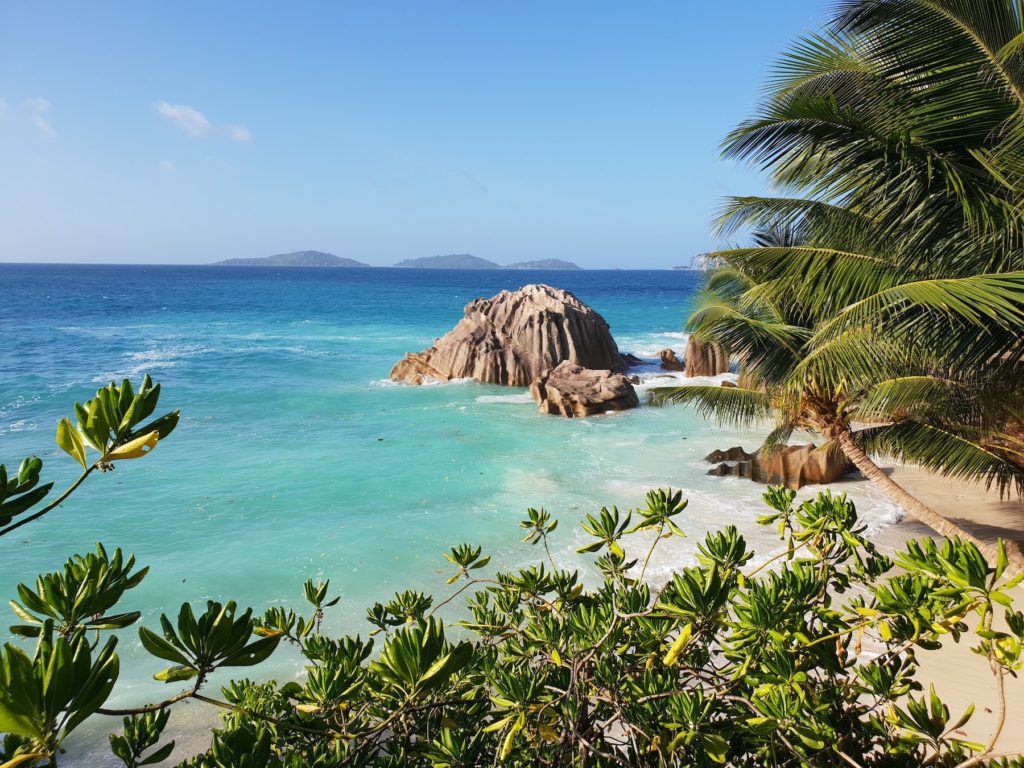
La Digue
La Digue, with its dramatic, sculptured granite rocks and exquisite, secluded beaches, is a laid-back, inviting island in the sun. It lies 50km northeast of Mahé, 4km east of Praslin and is the fourth largest of the granitic islands. The island is about 6km long, a little more than 3km wide, and rises up to 333m at Nid d’Aigles, ‘Eagles Nest’, the highest peak.
The 10km2, island is almost completely encircled by coral reef and has no natural harbour. A jetty was built at La Passe on the west coast and a breakwater has been constructed to provide more shelter, particularly during the northwest monsoons.
Marion Dufresne, in his ship La Digue, made the first recorded discovery of this picturesque island in 1768, and the French took formal possession of it in 1771. Amid the lush vegetation, streams and swamps, the worst thing the early settlers had to contend with was the crocodiles, and they were soon eradicated along with the tortoises. The birdlife managed to cling on to a precarious existence, and the rare black paradise flycatcher is still present in low, but increasing numbers.
Gone are the days of the quiet life when there were traditional wooden Creole houses, ox-carts, fishing, boat-building and a simple lifestyle. Over the years there has been increasing development and the 3,000 residents are now mainly involved in tourism activities. There has been a great expansion in self-catering, guesthouse and small hotel accommodation. When the ferries arrive, it is rather congested at the jetty though you can be assured of a warm welcome and plenty of offers for bicycle hire.
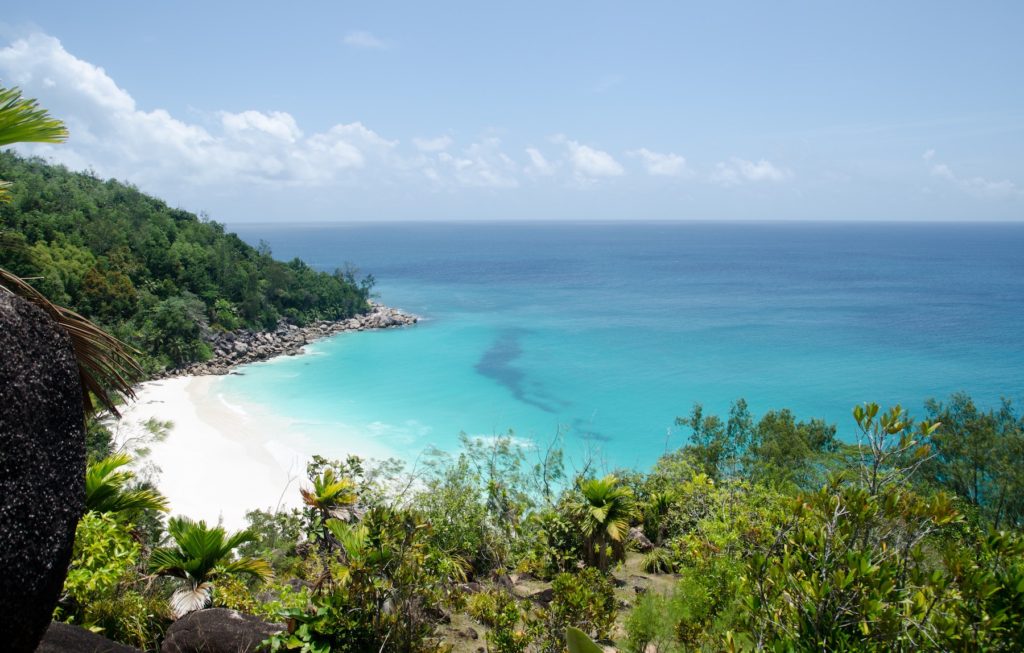
Praslin
Long stretches of fine, white sand framed by palms and shady takamakas, or small, secluded coves bounded by granite boulders, characterise this strangely shaped island surrounded by coral reefs. An assortment of islands lies beyond the coral reefs like chunks of emeralds in an azure sea.
Mahé, 45km away to the south, is hazy in the distance; Aride, the seabird sanctuary, lies 16km to the north; and enchanting La Digue is located a mere 4km to the east. Curieuse, off to the northeast, is surrounded by its marine park and Île St Pierre is a jumble of rocks lodged between Praslin and Curieuse. Cousin, an island bird reserve, and privately owned Cousine, lie to the west. Round Island, at the entrance to Baie Ste Anne, and Chauve Souris, a tiny clump of tree-covered rocks just 500m off Anse Volbert, complete the assorted satellite islands.
Areas of great natural beauty surround Praslin and the romantic ‘island of palms’ is the only place on earth where you will see coco de mer palms growing in magnificent profusion. The tall, elegant female coco de mer palm produces a huge seed, astonishingly shaped like a female belly and thighs, and the taller male palm has a remarkably phallic-looking flowering catkin. As can be imagined, these erotic shapes have resulted in the perpetuation of many myths and legends.
Although a large amount of the original forest has disappeared as a result of fires and deforestation, there is still a valley where the remarkable palms are protected and flourish – the Vallée de Mai, a World Heritage Site. There you can enjoy the majestic splendour of the forest and see all six of the endemic palm species of the Seychelles plus an array of other trees and plants.
The nearby island of Curieuse and the newly created special reserve of Fond Ferdinand in the south of Praslin are the only other places where coco de mer palms can be found growing naturally. Praslin is not only famous for the palms but it is also home to the rare endemic black parrot, and though these birds are never easy to find, they can be seen in any of the natural areas on the island.
What to see and do on Praslin
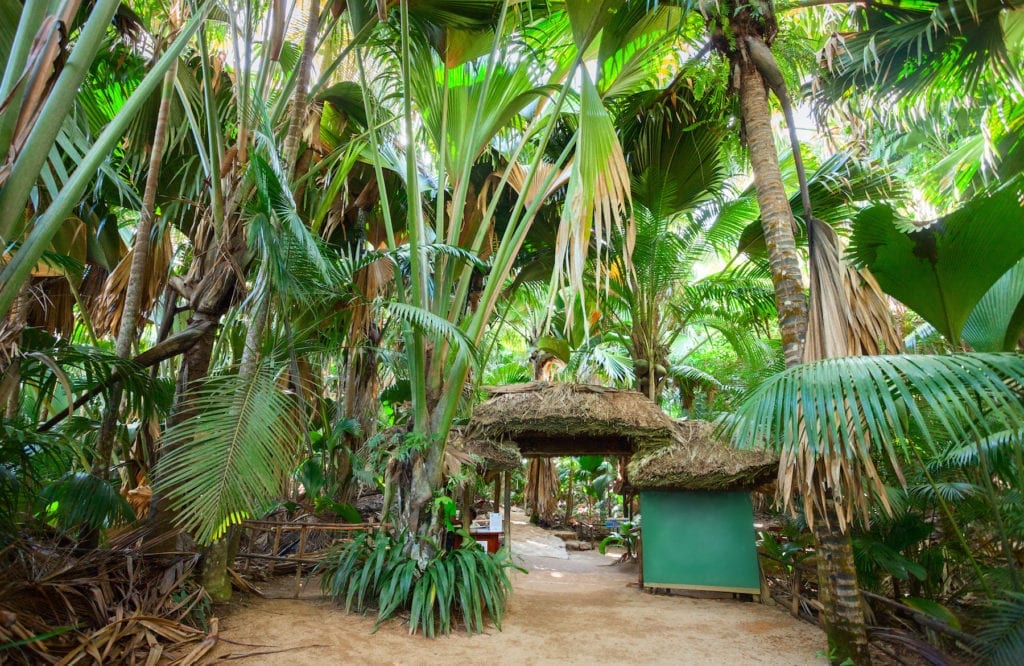
Vallée de Mai
The UNESCO World Heritage Site of Vallée de Mai is a tiny enclave of 20ha within the Praslin National Park, and is home to some 4,000 coco de mer palms.
At the entrance to the park is a thatched shelter showing a detailed map of the area and there are usually a few coco de mer nuts with surrounding husks and flowers displayed on a bench. Pick up one of the nuts to feel the incredible weight. The well-maintained paths are clearly marked and easy to follow. In some places they are a little steep with steps, and there are boulders as stepping stones across the streams.
The shortest circular route of approximately 1km will take about an hour, allowing plenty of time to stop and examine all the interesting things described on informative multilingual plaques placed at various points along the way. Three hours are needed to complete the full north-to-south circular route, which includes a visit to the rustic shelter on the northern extremity. From there, the expansive views across the park give an idea of what the entire island must have looked like in its pristine state.
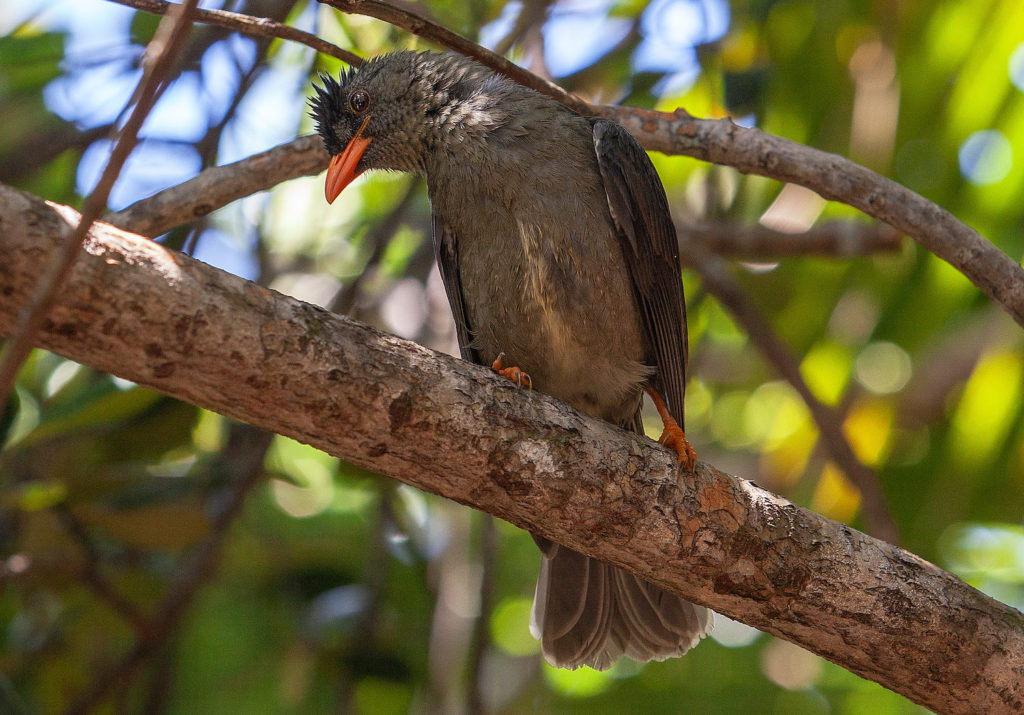
Ravin de Fond Ferdinand Nature Reserve
The paths and boardwalk take you along the lovely forested slopes of this 122ha reserve. Guided walks are offered through the indigenous vegetation up to a viewpoint (at least 100 steps!) taking about 2 hours up and down.
It can be very hot for the fairly steep climb so make sure you have water with you and preferably do it in the early morning. This is another place to see the famous coco de mer palms growing in the wild. Black parrots are often sighted in this area and the views over Baie St Anne are gorgeous.
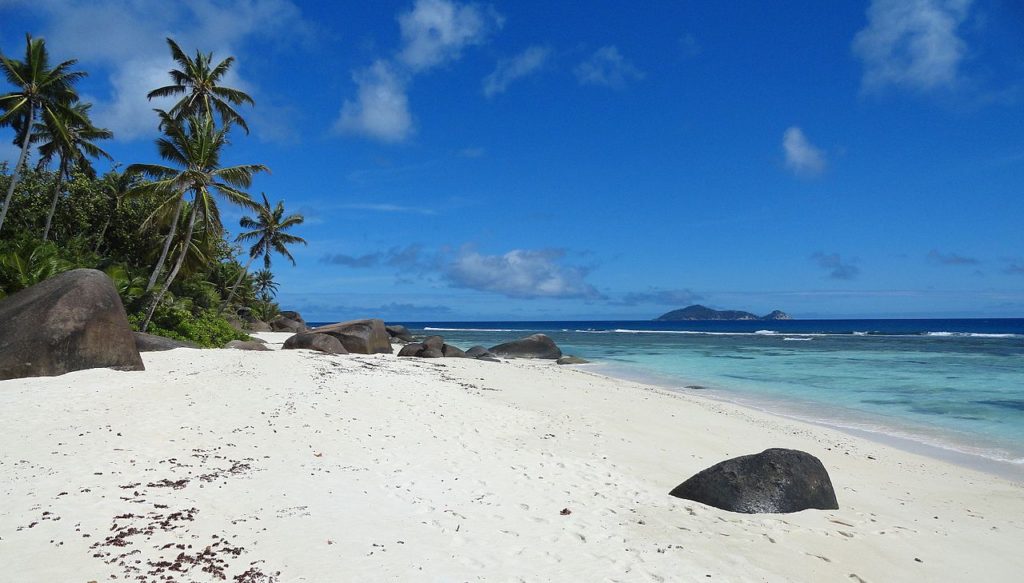
Silhouette
From Beau Vallon on Mahé, the familiar shape of this island is a silhouette against the sunset. The green and verdant isle rises out of the encircling coral reef to Mont Dauban at a height of 740m. It is almost round, roughly 5km in diameter, and covers an area of 20km2,. Because of the protective nature of the surrounding reef, landing on Silhouette has never been easy, and this has guarded the island from overdevelopment and exploitation.
It is probably the most densely vegetated island in the Indian Ocean, and its higher slopes and summit are clad in largely undisturbed, pristine forest with a high level of endemic flora and fauna. The Anse Mondon Valley is exceptionally rich in its biodiversity with many rare Seychelles hardwood trees, shrubs and orchids.
Silhouette has a population of about 200. The pace of life is slow: there are no roads, no motor cars, only one tractor and some electric buggies at Hilton Seychelles Labriz Resort and Spa, no police station and only one small shop selling essentials.
The Dauban family from Mauritius were the first settlers to arrive on Silhouette at the end of the 19th century. They gradually acquired the entire island and a thriving farming community developed. Coconut and cinnamon plantations were established on the fairly level plateau at about 500m, patchouli was grown for the perfume trade, fruit trees supplied the local market and, by the 1950s, the population had increased to around 1,000. However, after the crash in the world copra market most of the workers drifted back to Mahé.
Between November and March, birdwatching can be exciting as many migrants stop over on the island and, from time to time, it may be possible to see crab plovers, whimbrels, greenshanks and Eurasian oystercatchers to name but a few. The resident Seychelles kestrels are protected as is the rare sheath-tailed bat.
Silhouette is an island of great importance for its natural history (93% is under conservation) with about 75 endemic plant species and has recently been taken over by the Islands Development Company to run it as a nature reserve, but to date, they have done little to implement this.
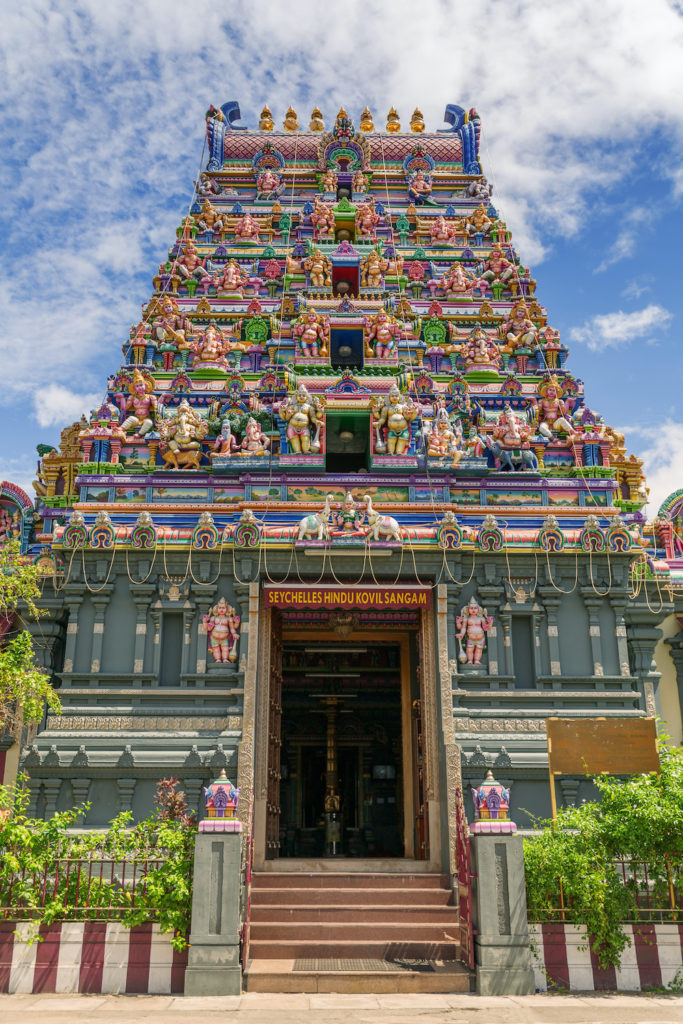
Victoria
Victoria, one of the smallest capitals in the world, nestles beneath the imposing granite mountains on the northeast side of Mahé on a ribbon of flat land edging the sheltered bay. It is an interesting little town with some typical Creole-style buildings interspersed with more modern architecture.
In keeping with the promotion of Creole culture, many of the new buildings follow the traditional style, and some even have a vaguely Indian influence with ornate archways and small tiles. There is a general air of prosperity, new buildings are under construction, the streets are generally clean, the people appear healthy and well fed, and there are no beggars. However, sometimes the shops simply do not have the specific item that you require as everything has to be imported.
Victoria is a busy commercial centre, well serviced by banks, shops and restaurants. Taxis and buses operating from the town centre provide easy connections with the rest of the island. As tourism has increased, so have the number of cars on the roads, and, at peak times, the traffic can be very slow moving.
At the inter-island quay in the harbour there are boats of all descriptions travelling to many of the islands, and the deep-water international quay provides access for large cruise ships and cargo vessels. Located between the two busy quays are the Seychelles Yacht Club and the Marine Charter Association.
What to see and do in Victoria
The Clock Tower
The clock tower is the focal point of the town and stands in the middle of the important intersection of Independence Avenue and Francis Rachel Street (Francis Rachel was the first Seychellois soldier to die in the 1977 coup). The silver-painted clock is a replica of that on London’s Vauxhall Bridge Road.
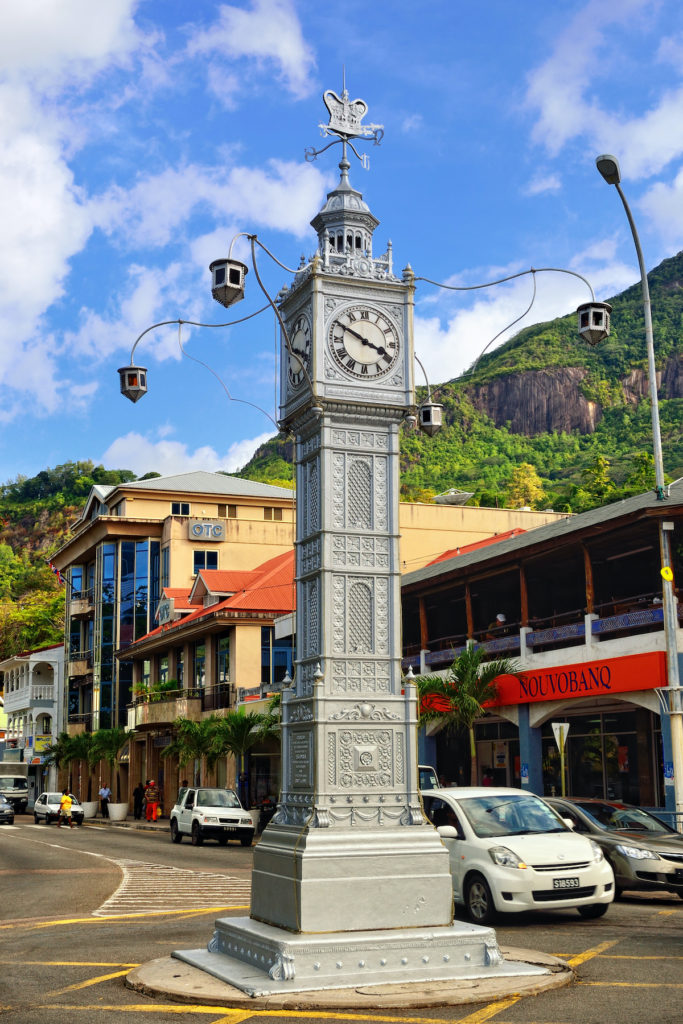
It arrived in the port in Mahé in 1903. As the clock was being unloaded, the pendulum accidentally fell into the water and was never recovered. Although a new one was made, the clock never chimed, and seldom displayed the correct time.
As a millennium treat, a new mechanism was installed, and a local businessman commented: ‘Its soul is full of memories, it gave freely the time to everyone, to work, play, think or just do nothing.’ The clock tower is a good starting point for setting out to explore Victoria on foot.
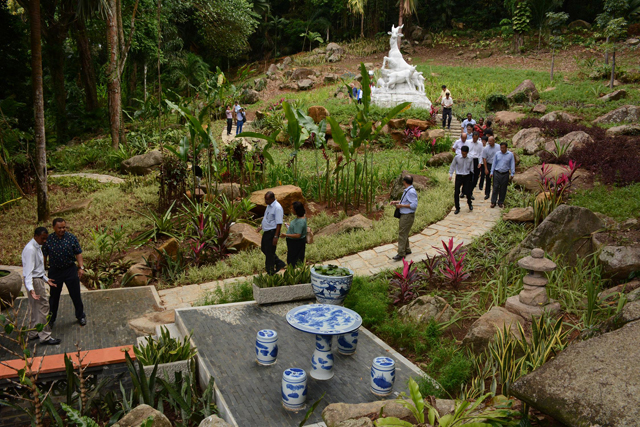
Victoria Botanical Gardens
The 6ha park, besides being a retreat from the bustle of Victoria, has a fascinating array of plants and houses an impressive collection of tropical palms, including the six Seychelles endemic species.
This is one of the best places to photograph both male and female coco de mer palms as they are out in the open and in good light. Notice the large coco de mer planted by HRH Duke of Edinburgh during his brief visit to the Seychelles in 1956. Further up the gentle slope is a large pen housing a collection of Aldabra tortoises.
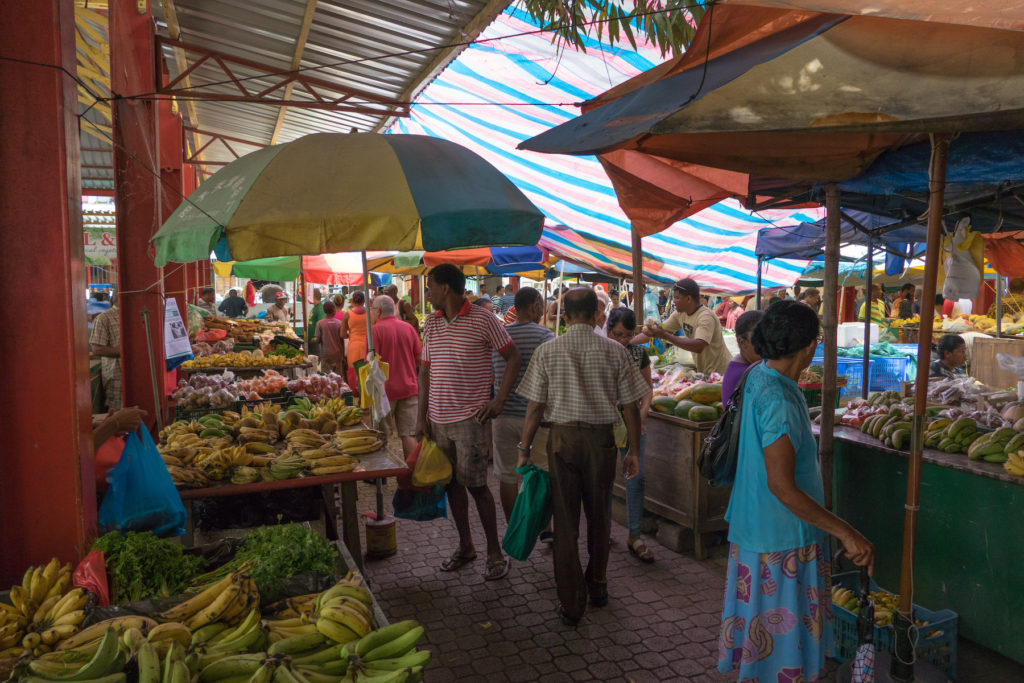
Victoria Market
This is the heart of town where the residents do their daily shopping. It is largely closed to traffic and always bustling with activity in the mornings. The Victoria Market was rebuilt and opened again in June 1999. It is still known as the Sir Selwyn Selwyn-Clarke Market, named after the last British governor of the Seychelles in the late 1940s.
The colourful market has a distinctly oriental look about it, with a bright turquoise pagoda-style roof and red supporting columns with splashes of yellow and dark blue. An enormous mango tree shades the central square, while frangipani trees with fragrant white flowers scent the air.
Related books
For more information, see our guide to the Seychelles:
Related articles
Explore the islands’ extraordinary biodiversity.
Explore the culinary treats of the Seychelles with two flavourful recipes.
